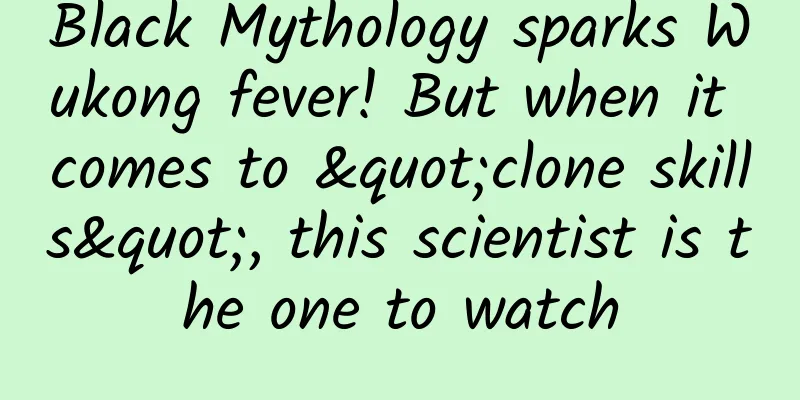Black Mythology sparks Wukong fever! But when it comes to "clone skills", this scientist is the one to watch

|
At 10 am on August 20, the domestic 3A game "Black Myth: Wukong" was officially launched. This groundbreaking work, which is highly anticipated by gamers around the world, was launched on a weekday, but it did not affect the enthusiasm of global players at all. After the game was released, it quickly exploded on social platforms at home and abroad and became the focus of everyone's attention. Speaking of "Journey to the West", people will definitely be impressed by the magical skills of Sun Wukong's clones: "Pull out a handful of hair, chew it up, spit it out, chant a spell, and shout: Change! The hair turns into thousands of little monkeys, showing their magical powers." Such cool skills, in fact, in the real world, are just "cloning technology" showing its magical powers. On November 27, 2017, the world's first somatic cell cloned monkey "Zhong Zhong" was born in China. On December 5 of the same year, the second macaque baby "Hua Hua" was born, marking the beginning of a new era in which China took the lead in using somatic cell cloned monkeys as experimental animal models. (Pictures from the Internet) Tracing back to its origins, this technology, Let me start with the story of this old man... Tong Dizhou pioneered the "cloning" technology in China and is known as the father of Chinese cloning. Tong Dizhou (Photo source: Study Times) When it comes to Tong Dizhou, you may be unfamiliar with him, but I believe many friends have seen the picture below. "Water Lily and Goldfish" (Photo credit: Institute of Oceanography) This painting was made by artist Wu Zuoren for Tong Dizhou. It vividly records the miracle of life science created by Tong Dizhou. Several small goldfish are playing and shuttling among the lotus leaves. The first one is different. It has a crucian carp tail but a goldfish body. The birth of this fish is a great demonstration of the theory of biological genetics. Later, the international biological community named this fish "Tongyu" after the breeder. Introduction Tong Dizhou, a native of Tong Village, Yin County, Zhejiang Province, studied in a private school and worked under the guidance of his father since he was a child. His father often encouraged him to study hard with the saying "dripping water wears away a stone" and hoped that he would achieve something in the future. In 1930, Tong Dizhou, with the financial support of his relatives and friends, traveled across the ocean to study at the University of Brussels, the capital of Belgium in Northern Europe. Under the guidance of Professor Blancher, a famous European biologist, he began to study embryology. However, the international environment at that time was not friendly to the Chinese. Racial prejudice and discrimination were like invisible barriers, hindering the steps of every overseas student. Faced with such a predicament, Tong Dizhou did not choose to retreat or complain, but turned this injustice into inner motivation, secretly vowing to prove himself with outstanding academic achievements and win glory for the country. Tong Dizhou works in the laboratory (Photo credit: Institute of Oceanography) On the road of scientific research, Tong Dizhou faced a very challenging task - to complete the egg membrane peeling surgery of frog eggs. Because frog eggs are tiny, only the size of millet grains, and are tightly wrapped by three layers of soft membranes as thin as egg whites, no one has been able to overcome this problem for many years. However, Tong Dizhou succeeded in his first attempt, and this achievement shocked the European biological community. Subsequently, he successfully completed a series of difficult experiments and published a number of high-quality academic papers. He gradually emerged in the academic world, and when he finally obtained his doctorate, he had become a highly regarded experimental embryologist. Faced with the favorable conditions abroad at the time and the retention of his mentor, Tong Dizhou resolutely chose to return to China and devote himself to the embrace of his war-torn motherland. "The sun and the moon wax and wane, so don't be discouraged by the scenery" During the Anti-Japanese War, Tong Dizhou successively served as a professor at the Medical College of Central University, the Department of Biology of Tongji University, and the Department of Biology of Fudan University. Although the life of refugee was very difficult, Tong Dizhou insisted on teaching students and never gave up his favorite scientific research. Without a microscope, the couple borrowed money to buy a second-hand one, and it took them 11 years to pay off the microscope. Without light, he continued to conduct research outdoors regardless of winter or summer, and he never retreated even if he was sweating profusely or his hands and feet were stiff. Microscope (Photo source: Voice of China Association for Science and Technology) After the founding of the People's Republic of China, Tong Dizhou continued to delve into the field of embryology and took the lead in exploring cloning technology. In 1950, he was ordered to co-found the first marine science research institution in New China, the Qingdao Marine Biology Laboratory of the Institute of Hydrobiology, Chinese Academy of Sciences (the predecessor of the Institute of Oceanology, Chinese Academy of Sciences), with Zeng Chengkui and Zhang Xi. In 1963, Tong Dizhou made a breakthrough. He successfully cultivated China's first cloned female carp by injecting genetic material from male carp into female carp eggs. This achievement pioneered the world's fish cloning. Cloned female carp (Photo source: Voice of China Association for Science and Technology) In the 1970s, Tong Dizhou further proposed the idea of cloning mammals, and in 1978, he and Luo Zongluo tried the "nuclear transplantation" experiment between animal and plant cells. Inspired by this, his students continued to explore in the following years and successfully carried out research on cloning cows and sheep. Cloned sheep (Photo source: Voice of China Association for Science and Technology) Unfortunately, in 1979, this outstanding warrior on the scientific research front died of a heart attack due to overwork in the preparation of goldfish breeding research. 20 days before his death, Mr. Tong Dizhou was interviewed by a reporter from China Youth Daily and gave a message to Chinese youth: "Think broadly and work rigorously." This short and profound statement is not only a summary of his scientific research career, but also his earnest expectation for the younger generation. References [1] "For the New China" | Tong Dizhou, the Father of Chinese Cloning [OL]. Voice of China Association for Science and Technology, October 12, 2019 [2] "In Memory of the 110th Anniversary of the Birth of Mr. Tong Dizhou - A Pioneer in Leading Chinese Cloning to the World" [OL]. Institute of Oceanology, May 25, 2012 |
<<: "See through!" Chinese scientists take first complete X-ray of the moon
>>: Thump! Thump! Thump! Can I still exercise if my heart is beating fast?
Recommend
The market size of smart hardware will reach 50 billion yuan, and smart home will become a new trend
Three years ago, the emergence of smart bracelets...
In-depth|What does OpenAI really want?
【Editor's Note】At the end of last year, OpenA...
Artificial intelligence, “abandoning” real data sets?
Currently, artificial intelligence technology has...
4 strategies + 7 tips, a comprehensive interpretation of Xiaohongshu promotion strategy!
If you ask me which platform users enjoy watching...
Taking calcium supplements every day, still lacking calcium? These habits are quietly "stealing" your calcium
Now more and more middle-aged and elderly people ...
The doctor said I have a "nodule". Is it okay not to have it removed?
Reviewer: Qu Bo Chief Physician of General Surger...
Cheese Rhythm Cao Maogui Wealth Secret Key Stock Market Training Course 10 Videos
Cheese Rhythm Cao Maogui Wealth Secret Key Stock M...
The 10 most disappointing founders of 2015
[[161252]] Editor's note: In this article, St...
Lee Jong Suk and Jun Ji Hyun will gradually fade away. Which one do you choose, patriotism or idols?
Although the "Korean Restriction Order"...
If there are few “half moons” on the nails, does it mean that your body is unhealthy?
There are many rumors about the half-moons on the...
A reminder to domestic brands obsessed with price wars: Japanese brands are preparing for a big move by cutting fuel prices while building factories
In the past two years, sales of Japanese cars in ...
Boy puts "Seagull" into glass bottle? Fined 2000!
Recently, at the Haigeng Dam next to Dianchi Lake...
B station marketing promotion methods and strategies!
Brand marketing is a long-term thing. The communi...
Why don’t startups choose to develop Android apps first?
[[153581]] In the mobile application field, espec...
They dare to squeeze into any narrow place. Are cats actually liquid?
Leviathan Press: Cat owners know the flexibility ...









